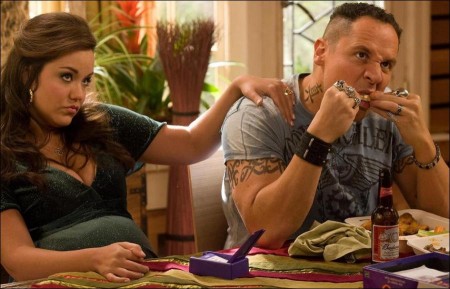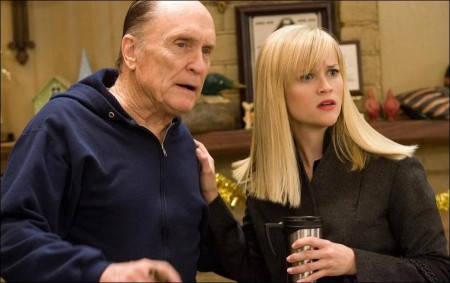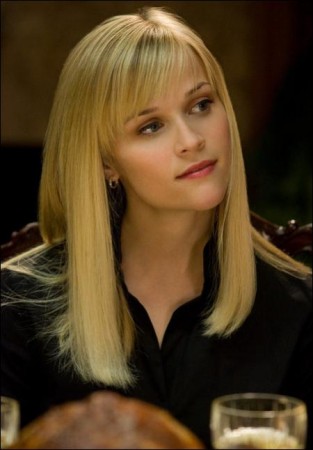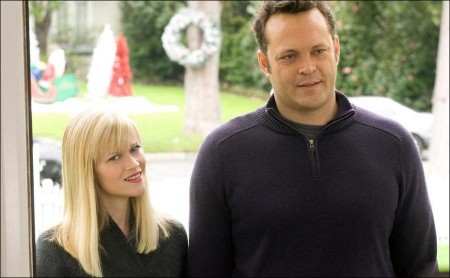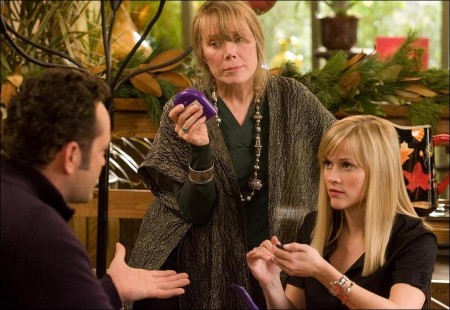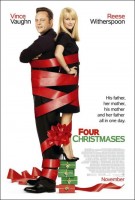When upscale, happily unmarried San Francisco couple Kate and Brad find themselves socked in by fog on Christmas morning, their exotic vacation plans morph into the family-centric holiday they had, until now, gleefully avoided. Out of obligation–and unable to escape–they trudge to not one, not two, but four relative-choked festivities, increasingly mortified to find childhood fears raised, adolescent wounds reopened…and their very future together uncertain.
As Brad counts the hours to when he can get away from their parents, step-parents, siblings and an assortment of nieces and nephews, Kate is starting to hear the ticking of a different kind of clock. And by the end of the day, she is beginning to wonder if their crazy families’ choices are not so crazy after all.
“This is a movie about the universal theme of the holidays: anxiety,” director Seth Gordon deadpans, observing that “holidays, home and family have a way of bringing us back to our roots and exposing our vulnerabilities like nothing else. Which, of course, is fertile ground for comedy.”
More specifically, he adds, “`Four Christmases’ is about the ongoing struggle we all face, between who we are versus who we were raised to be and, ultimately, who we need to become. That’s why going home can be so difficult. The minute you walk in that door you’re confronted by images of who you used to be-or how your parents and siblings still see you-and maybe that’s not who you are anymore. It’s instant discomfort.”
The only thing worse than having to suffer such a humbling and embarrassing experience would be having to do it in the company of your significant other, that one person above all others in the world you want to think you’re cool. Or, at least, normal. Or, at the very least, not genetically compromised by that socially dysfunctional hive you call family.
“In `Four Christmases,’ Brad and Kate feel that discomfort to the extreme, because they’re seeing their histories for the first time through each other’s eyes,” says Jonathan Glickman, who, along with Roger Birnbaum and Gary Barber, produced the film. “For three years, they’ve been relating as sophisticated, attractive, confident people. In the course of this one day they see the worst of each other, everything they’ve been trying to hide and protect themselves from. It all comes out.”
“The truth is, no matter how much you think you know a person, you can always learn more by watching them interact with family and seeing their childhoods revealed. Parents and siblings really know how to push those buttons,” says Vince Vaughn, who stars as Brad.
Reese Witherspoon, who stars as Kate, acknowledges, “The truth is, people tend to evaluate their own relationships in comparison to that of their parents, and that can be a daunting prospect in many ways.”
That’s precisely why Brad and Kate have been deftly sidestepping the show-and-tell, notes Vaughn. “They really love each other and don’t want to ruin it. As the story progresses, you realize how they’ve been hurt by their childhoods and the demise of their parents’ marriages. They see the stresses and obligations of family life but none of its joy. So they reinvent themselves as independent adults and stay away to avoid making the mistakes their parents made and so have a happier life.”
It’s a plan that has been working fairly well, until their Christmas escape gets cancelled and they are suddenly forced to deal with everything…together…all at once. “When Brad and Kate get caught at the airport and roped into a round of family visits, it results in some uncomfortable, long overdue and very funny moments, as they begin to discover some not-so-flattering aspects of each others’ pasts. The story then becomes not only about whether or not their relationship will survive long-term in the light of all this honesty, but whether it will survive the day,” says Peter Billingsley, one of the film’s executive producers. Billingsley also turns in a cameo as an airline ticket agent facing the couple’s frustration when their holiday plans implode.
Appropriately enough, production on “Four Christmases” began in early December, then took a break for the holidays, allowing cast and crew their own private celebrations with loved ones. Naturally, the themes of the movie followed them home. For most, it provided additional comic ammunition for their return to the set.
Gordon recalls, “During the hiatus, I was reminded why this story is so universal. It was tense at home: my sister was annoyed with me, there was this whole thing about who was picking up Grandma for dinner, and I thought, `This is what makes Christmas funny.’ So many details rang true from the movie and made me feel the way I did when I laughed out loud reading the script for the first time. This movie takes all those family dynamics everyone relates to, and just pushes them out a lot farther.”
“Everyone brought their neuroses to the table,” Glickman confirms. “Whether it was the director, the screenwriters, the actors-everyone has experienced some version of this. We can all relate, no matter how we feel about our individual families, and we all have stories. There are some of Vince’s own experiences in here, some of Reese’s-it’s a mix of everyone’s ideas.”
“As a documentarian,” he adds, “Seth commits to an essential structure but he’s willing to let things unfold and, for this kind of movie and this kind of cast, that’s exactly what we needed.”
Seth Gordon earned widespread acclaim, including a nomination from the Chicago Film Critics Association, for his 2007 documentary “The King of Kong: A Fistful of Quarters,” which chronicled an intense rivalry between two men for a video game championship. Offering both humorous and poignant insights, it captured the attention of the “Four Christmases” producers as well as Vince Vaughn, who says, “My thought was, `this guy is really fresh and funny and thinks outside the box.’”
Supporting Vaughn and Witherspoon in their “Four Christmases” relay is an outstanding ensemble of acclaimed artists whose careers encompass, collectively, the stage, screen, television and music industry. Robert Duvall and Sissy Spacek portray Brad’s long-divorced parents Howard and Paula, whose lives since their split have grown so far apart it’s hard to believe they still share the same language, while Mary Steenburgen and Jon Voight star as Kate’s equally incompatible parents, Marilyn and Creighton.
Dwight Yoakam stars as Pastor Phil, Marilyn’s latest in a series of boyfriends for whom she transforms her life. Jon Favreau and Tim McGraw gang up on Brad as his big brothers Denver and Dallas, and Kristin Chenoweth, as Courtney, puts Kate in her place with a dose of sibling rivalry, sister-style.
Says Gordon, “These are some of the best actors of their generation-of any generation-and their commitment took everything to a higher level. I would have felt lucky to have worked with any one of them.”
Throughout production, collaboration most often took the form of improv, with Vaughn setting the pace for the ensemble cast as they explored the comic potential of key scenes and generated new punch lines.
“Vince is a force of nature,” Witherspoon attests. “You just let him do his thing and hope you can react around him. He’s extraordinarily good at being funny but it’s not all for laughs; he never loses sight of where the character is going and the level of emotion involved. I had a lot of fun bouncing ideas around with him and the other actors, watching the story grow and develop. Sometimes we’d feel that we really pinned down a scene and then someone would think of another angle and we’d go back and add more, kind of layering things on top of each other and seeing what works. It was great to see people so inspired and excited about a project.”
“Reese’s reactions and comebacks were easy to play off, because she comes into it with such an understanding of her character that she can be comfortable playing around in the moment,” says Vaughn. “Improv isn’t just saying whatever comes into your head when the cameras roll; you have to have a game plan. It’s about figuring out what serves the scene.”
First Christmas: Brad’s Father, Howard
Brad and Kate start their festivities with a bang (and a crash) at Brad’s childhood home. Here, his father Howard, played by Robert Duvall, has ruled supreme in butt-scratching bachelorhood since Brad’s mother bailed out some 20 years ago, and it shows. From the Ultimate Fighting Championship posters and the motley collection of furred creatures that Brad’s brothers have personally shot and stuffed, to Howard’s old rabbit-eared TV and his fridge full of beer, “this is clearly a case of testosterone run amok,” says Glickman. “With no female interference there’s no modulating his behavior and Howard is a wild man. It’s like a house of wolves.”
Howard’s not a bad guy, Duvall offers, “just the kind of a guy who prefers life to the beat of his own drum. It’s a crazy dysfunctional existence and we certainly heightened that aspect of it but, the truth is, no matter what you can concoct in your imagination, you know that circumstance exists in some form somewhere. I’m not pointing any fingers,” he laughs, “but you can bet there are families like this.”
Chips off the old block, Brad’s UFC-wannabe siblings, Denver and Dallas, greet him with a flying tackle that slams him flat on his back, taking him instantly back to the days of his not-so-carefree youth.
Jon Favreau, a friend and frequent collaborator with Vaughn since before their career breakthroughs on the 1996 comedy “Swingers,” took on the role of Denver during a brief break from his directorial duties on the blockbuster “Iron Man.” “I don’t think Denver is much of a deep thinker,” he admits. “He’s more a man of action as opposed to contemplation. He and his brother aspire to be famous cage fighters, and even though they haven’t been very successful at it, it’s not for lack of practice. When it comes to Brad, I think they harbor some jealousy over the fact that he’s become a successful lawyer.”
“Consequently, as his older brothers, it’s their duty to put him in his place,” adds multi-platinum-selling singer/songwriter Tim McGraw, whose standout performance in the 2005 drama “Friday Night Lights” prompted the “Four Christmases” filmmakers to offer him the role of Denver’s main sparring partner, Dallas. “I didn’t need much research for the part,” McGraw jokes. “These are grown men who act like 16-year-olds, and that’s not too much of a stretch for me. But I had to seriously get into shape for all the wrestling. That Favreau is no lightweight. I had to work hard to kick his butt.”
Vaughn credits Favreau with helping develop the brothers’ obsession. “We saw them as ultimate fighters, but not great ones you would see on Pay-Per-View, more like guys who fight in people’s backyards and then post the videos on YouTube. Favreau took that idea and ran with it, complete with the Mohawk and the tattoos.”
The inevitable outcome of their rivalry is a test of wills that takes place, disastrously, on the roof of Howard’s house, where Brad attempts to assert his mechanical skill by installing a satellite dish while his brothers give him just enough line to hang himself. Literally. Meanwhile, Kate takes refuge in the kitchen with Denver’s pregnant wife, Susan, played by Katy Mixon (“The Informers”), who lets Kate baby-sit her firstborn, with equally traumatic results.
By the time Brad dusts himself off to go, he is so grateful to escape the house with all his ribs intact that he fails to notice a subtle change in Kate. For one quiet moment in the melee, as Brad reluctantly held his tiny niece, Kate looked across the room and saw her handsome-if flawed-man in a brand new light.
Second Christmas: Kate’s Mother, Marilyn
The absence of Marilyn’s familiar Christmas decorations out front is balanced by a life-size statue of Jesus with outstretched arms, prompting Kate to wonder who her mother’s current beau is and what other influences he may be exerting on the household. Mary Steenburgen, who stars as Marilyn, explains. “She has had a lot of boyfriends. Marilyn is always looking for true love, and even though it eludes her, she remains hopeful that the next man will be the one. With every new boyfriend, she adapts herself and her life completely to his tastes and interests, so that Kate never knows who or what she’s going to find when she comes home.”
While Marilyn fusses over Brad in habitual homage to anything tall, dark and handsome, Kate has a prickly reunion with her sister Courtney, played by Kristin Chenoweth. A former cheerleader, she is, says Gordon, “one of those girls who peaked in high school and hasn’t quite gotten over it, though she remains fiercely positive. We needed an actress in that part who could pull off being really nasty to her sister but still remain relatable and likeable in her own way, and Kristin was absolutely perfect.”
It didn’t hurt that, as Witherspoon points out, “We’re both Southern, small and blonde, so we already look like family. It was a thrill to work with Kristin and create the kind of sibling relationship where we get to tear each other’s hair out a little but still make it clear that there’s a deep and loving bond at its core.”
Says Chenoweth, “Courtney was the big success in high school, while Kate was awkward and unpopular. Courtney expected to get the prize husband and have the perfect socialite life, but things didn’t work out that way. Meanwhile, Kate grew into a real swan, with a great job and a cool boyfriend. So now it’s big sister’s chance to remind Kate-and by the way, Brad-of what she used to look like and what a loser she was.
The holiday observance soon moves to Marilyn’s church, where her newfound religious commitment is explained by the introduction of her latest love interest: the charismatic Pastor Phil, played by country music superstar and acclaimed actor Dwight Yoakam, who truly made the role his own.
“Pastor Phil was originally meant to play guitar and deliver a brief sermon, but Dwight brought such stature and swagger to it, with his arms raised and a booming voice that played to the furthest pews,” says Gordon. The ensuing brainstorming process eventually produced a giant video screen backdrop with a close-up on his face, a light show, music and a full stage to back him up.
Yoakam reveals, “It was a kind of exploration into moments I’ve had in my own life, growing up in a fundamentalist church, and I mean that with the greatest affection. The best preachers in that tradition can sometimes be very dramatic in their presentation and speaking style to the point where it can take on some absurd elements, but you know at the heart of it is someone earnestly trying to communicate an idea. In this case, it’s universal love. That’s what Pastor Phil is all about.”
As things rapidly deteriorate from bad to worse, Brad and the extremely stage-frightened Kate are drafted as substitute leads in the church’s Christmas pageant, where, under blinding lights and attention, their every miscommunication is amplified. By the time they make their exit and head off to the next stop on the day’s agenda, they are barely speaking to each other.
Third Christmas: Brad’s Mother, Paula
At first glance, Paula’s place in Marin seems inviting and comfortable: an airy, pillow-strewn New Age sanctuary and the perfect antidote to the Pastor Phil Show…so what, exactly, could be making Brad so uptight here? Perhaps it’s the fact that Paula’s journey toward self-actualization has picked up an eager hitchhiker in the form of Brad’s former high school buddy Darryl, played by “Swingers” alum Patrick Van Horn. Now Paula’s soul mate/life partner, Darryl vacillates between wanting to high-five his old friend and playing “Stepfather Knows Best.”
“That was totally Vince,” Gordon credits. “He suggested, `what if she’s sleeping with her son’s best friend from high school?’ and it became this amazing squirm-worthy scene that simultaneously explains how Brad has become so estranged from his mother.”
Paula is played by Sissy Spacek, enjoying what she calls “a rare opportunity to cut loose in a fast-paced comedy,” and likening the experience to “catching a moving train and trying to stay out from under the wheels.”
Indisputably, though, it was Spacek who set the rhythm for Brad and Kate during their crash-and-burn round of Taboo, a game in which players try to get their partners to guess a secret word from their shorthand clues. Though the scene was scripted, it was decided at the last minute to have the actors forego the pre-selected cards and choose at random from the deck, as if playing the game in earnest. “It ended up serving the story better, in bringing out aspects of their relationship in this very public setting,” says Gordon.
Entrusted with the penalty buzzer, Paula proves not too clear on the rules. Says Spacek, “Paula thought she was playing the game the way it was meant to be played but kept screwing it up. She was supposed to be buzzing Kate but was buzzing Brad instead, and at the wrong times and they kept looking at her like, `what?!’ Considering that Paula is supposed to be a very well-educated, sophisticated therapist, I think her IQ drops lower and lower as the scene progresses. We should pity her patients.”
The speed and spontaneity of Taboo can prompt players to blurt out responses without thinking, exposing hidden feelings. More importantly, it relies a great deal on the strength of personal connections, as players reach for phrases their partners should understand. That Brad and Kate’s performance doesn’t speak well for their communication skills might indicate that they don’t know each other as well as they thought. Or maybe, as Kate is beginning to believe, that they shouldn’t even be together at all.
Fourth Christmas: Kate’s Father, Creighton
By the time they reach their fourth and final destination, the Lake Tahoe retreat of Kate’s father Creighton, played by Jon Voight, they have made some tough decisions. Upon their arrival, only Kate gets out of the car.
Once inside, she has an unexpected conversation with her Dad. Voight, who first worked with Reese Witherspoon on the 1993 Western drama “Return to Lonesome Dove,” suggests, “It’s a simple scene but it’s heartfelt in a way that, I believe, many people will find true. Creighton tries to explain some of the mistakes he made in his life and as a father, and it gives Kate a lot to think about.”
Says Gordon, “Creighton was one of the toughest characters to figure out. He isn’t introduced early in the film but, rather, becomes this vital chess piece in the story, to sort of sum up everything that has happened thus far and set up the conclusion of the film. Creighton’s interaction with Kate really crystalizes everything.”
“Jon has such gravity,” Witherspoon states. “He’s a very thoughtful and sincere actor. He brought so much to his scenes in which he tries to make amends for the way he let her down. It was a beautiful performance and we were all moved.”
“Vince suggested Jon from the get-go as someone who could handle the interaction emotionally without making it heavy, to give it meaning and drama but have some sweetness to it, that fit the tone of the film overall,” says Glickman. “We used the same rationale in casting all of the parental roles. Rather than looking for comedians, we wanted actors who knew how to make things funny, so we assembled these great actors-every one of them Academy Award® winners-who are renowned for their dramatic roles, and gave them a chance to let loose and have fun.”
Trained as an architect, Gordon spoke the same language as production designer Shepherd Frankel (“27 Dresses”) in setting parameters for the four family homes on Brad and Kate’s whirlwind tour. “Seth understands floor plans, models and the use of space. I loved working with him,” says Frankel, who holds a masters degree in architecture from UCLA. Details became more meaningful and layered as the characters developed, with Frankel using their finally fleshed-out histories to inform his designs. “We weren’t preparing four houses but four individual living environments.”
“Each household, like its owner, has its own distinctive vibe,” says Glickman. Gordon explains, “We constructed an elaborate back-story and timelines for all the family members so we could make sense of when things fell apart-which kid would likely have gone to live with which parent, and so forth. In Brad’s case, for example, he obviously went to live with his more civilized mother at an early age and they become close, while his brothers bunked with Dad in the `bachelor cave.’ Paula started over, went to school, became a therapist and moved to Marin, and we imagined what her world would look like: stained glass and eclectic, international furnishings, hand-loomed rugs, piles of books, mementos from travel…a kind of a hippie academic aesthetic. You would never mistake her home for any of the others, or vice versa, and that’s thanks to Shepherd’s virtuosity. Our goal was a commitment to the absurd, but in a way that no one would question.”
In contrast, Paula’s ex, Brad’s father Howard, has happily settled into a state of unchallenged male-centric comfort in what Gordon describes as “a ranch-style tract home that has seen better days.”
“We get the feeling that his house hasn’t had the slightest upgrade since Paula moved out and since the two teenage boys pretty much wrecked the place,” says Frankel. “It has the classic cottage cheese ceiling, fluorescent lighting and 1970s-style accordion doors to the kitchen and, of course, the old-school turntable and TV.”
If the house has changed at all in the last 20-plus years, the designer suggests, “it’s only in Howard’s decorative embellishments that highlight his hobbies and those of his boys-specifically, hunting and fighting-complete with a taxidermy collection of squirrels, chipmunks and a skunk set into shadow boxes in the wall. Even his Christmas spread looks like the same old thing he busts out of the garage every year.”
Christmas decoration is also meaningful at the home of Kate’s mother, Marilyn- or, rather, the conspicuous lack thereof. It’s a clear indication to Kate that Marilyn has a new man, whose influence has prompted her to eschew her usual Santa and reindeer for something a tad more spiritual.
In keeping with Marilyn’s malleable personality, her home is characterized by what Frankel describes as “surfaces and veneers, reflecting no real sense of self.” At the same time, it reveals a dedication to symmetry and order, with wallpapers matched to upholstery patterns, suggesting the hand of a woman who is constantly striving toward some higher standard of domestic design as much as she strives for the perfect relationship.
Finally, it’s a set designed to embarrass Kate, with items from the past poised like tiny land mines to blow up in her face, including photos that chronicle some of the lowest points of her unpopular youth. Worst of all is the inflatable house of horrors she calls a jump-jump, in which Kate relives a painful memory from her childhood. As an adjunct to Marilyn’s house, the party moves briefly to The United Church of Faith and Worship, Piedmont Branch, to showcase Pastor Phil in all his glory.
The church was an environment that morphed considerably from its earliest conception, as Frankel outlines. “Pastor Phil’s sermon was originally written as something with a dilapidated smoke machine on a bare stage, but once Dwight got involved, it turned into a real rock n’ roll event with projection screens and lighting cues and neon illuminating the nativity. We did keep the smoke, though, and made it a key visual element to the set.”
All but one of the interior sets were built on Ren-Mar Studios soundstages. Pastor Phil’s devoted screen congregation filled pews at an existing church in Hawthorne, California. Exterior views of Paula’s zen-styled living space were captured outside a private home in Topanga Canyon, while the minimalist entrance to Marilyn’s house was finished on a studio soundstage. But the exterior shell and roof of Howard’s house had to be constructed, from scratch, on a bluff in the Shadow Hills area of Southern California’s San Fernando Valley.
“We were concerned about safety because it had to support the actors on the roof and had to be accessible for the crew to move around with their cameras and equipment,” notes Gordon. “Howard’s house was built from the ground up and had trap doors to allow access to the roof. We used scissor lifts to shoot from, as well as a huge Titan crane so we could fly around on all sides.” The illusion was so expertly crafted that, Frankel recalls, “Some of the cast and crew were shocked when they walked through the front door into nothing. They were asking, `where’s the rest of it?’ That’s the best compliment I could get-for them to think it was an actual house.”
Production captured locations in and around San Francisco, including the Golden Gate Bridge, Fisherman’s Wharf, Union Square, the Embarcadero, Chinatown and the San Francisco International Airport. For the opening airport scene, they used an existing terminal, which they filled with 500 extras.
Shooting at the airport was pure serendipity, triggered one evening as the director was returning from a location scout in San Francisco. Gordon relates, “I went to the wrong terminal for my flight and ended up having to walk through a whole section that was closed for remodeling, to get to the gate. It was the perfect spot. All we had to do was put up our own signage.”
The fourth and final stop on Brad and Kate’s emotional rollercoaster ride is Kate’s father’s place, set in Lake Tahoe. Befitting the mood of her visit, Gordon envisioned the setting as the most traditional of the four, a home in a classic, almost nostalgic sense, from its formal entry to the spacious dining room, warm lighting and textured wall coverings.
Both interiors and exteriors of Creighton’s house were shot at the Boddy House at Descanso Gardens, a public garden and historic site in La Cañada Flintridge, Southern California. Once the residence of Los Angeles Daily News owner and Descanso Gardens founder Manchester Boddy, the Hollywood Regency-style mansion was designed by “Architect to the Stars” James E. Dolena in 1938, and boasts a dramatic 180-degree view of the San Gabriel Mountains through a canopy of oak trees.
As the journey’s end point, “It also had to evoke the most traditional Christmas images,” says Frankel. “We dressed the greens and built a tree out of poinsettias and lights because it’s a nighttime scene and we wanted a beautifully romantic look. Inside, we built a large fireplace and hearth that serves as an iconic image of family gathering, and turned a study into a dining room by building wood paneling to hide bookshelves and adding sconces and wallpaper.”
Creighton’s house is not only the end of the journey logistically, but in the way that Kate and Brad have run the gamut of the day’s emotions and come to a new understanding of what they mean to each other. “We knew the minute we decided to make `Four Christmases’ that there had to be an emotional heart to it. We expected it would be funny because of the premise and all the physical comedy, but we also knew it had a touching underlying theme of two people coming to terms with their pasts so that they might have a future together,” says Glickman.
“By the time they reach the second house on their odyssey,” Gordon reveals, “it should begin to sneak up on the audience that even though we’re putting them through these humiliating experiences for laughs, the real story is all the stuff they’ve been hiding from each other. The truth is going to come out and it might drive them into two different directions. But if they don’t deal with it and accept it, they’ll never get to know each other for who they really are.”
Likewise, they’ll never get to know and love their families for who they really are. “The bottom line is, no one can drive you crazy like your family,” says Glickman. “Still, you’ll drive 100 miles in the snow, sit in airports for hours, just to be with them on the holidays. It’s the human condition. We cannot deny them.”
As Kate and Brad’s ordeal unfolds, Billingsley observes, “First you think they’re insane for not wanting to spend time with their families, then you go with them to all these homes and realize that they’re the only sane ones in the bunch. Finally, you realize that the families aren’t insane either. Everyone is just trying to find love and do the best they can.” Says Witherspoon, “Family is so important. You have to accept them as they are because, honestly, they’re not going to change.”
“Ultimately, the story is about what the holiday season itself is largely about: being thankful for your family-the good, the bad and the ugly of it-and being appreciative for the love you have,” says Vaughn. “Of course,” he adds with a smile, “none of that has to get in the way of having a lot of fun.”
Production notes provided by New Line Cinema.
Four Christmases
Starring: Vince Vaughn, Reese Witherspoon, Robert Duvall, Sissy Spacek, Mary Steenburgen, Jon Favreau, Jon Voight
Directed by: Seth Gordon
Screenplay by: Matt R. Allen, Caleb Wilson, Jon Lucas
Release: November 26, 2008
MPAA Rating: R for sequences of grisly bloody violence and torture, language and brief nudity.
Studio: New Line Cinema
Box Office Totals
Domestic: $120,146,040 (73.5%)
Foreign: $43,354,961 (26.5%)
Total: $163,501,001 (Worldwide)

